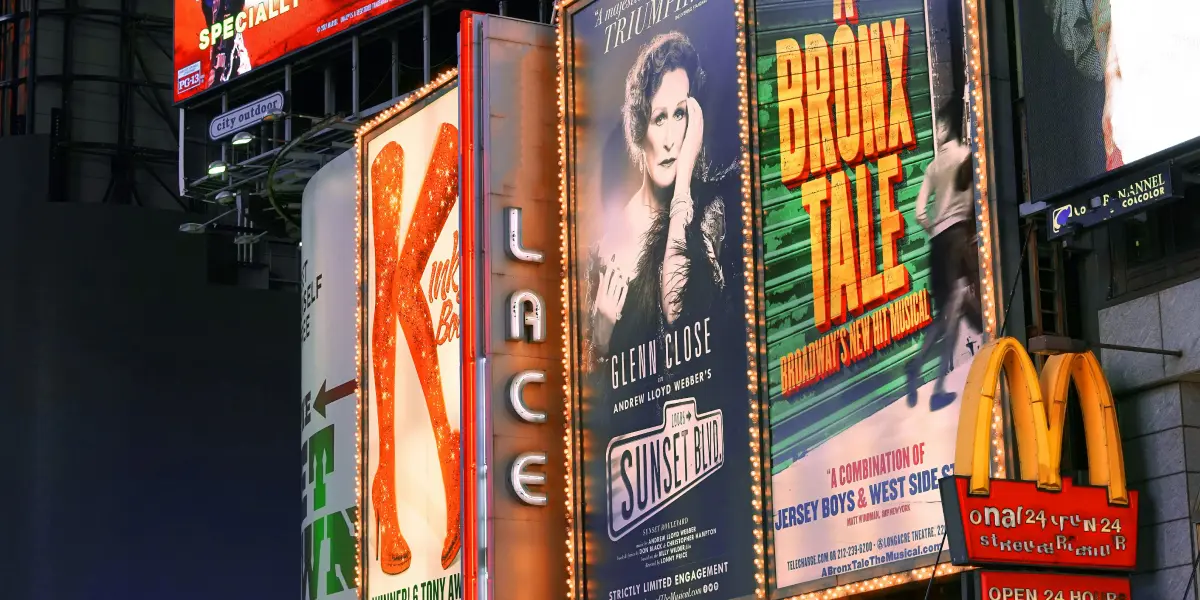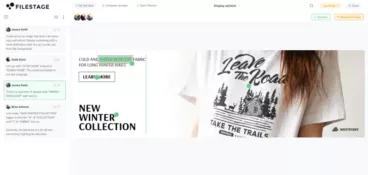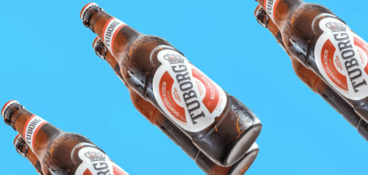59% of US consumers say they have been influenced by false advertising claims, according to Gitnux.
This explains why just 4% of customers believe advertisers practice integrity.
Whether it’s exaggerated claims, greenwashing, or misleading advertising, tricking your customers into buying your products is a costly mistake.
Just ask Volkswagen, who had to fork out $25 billion for Dieselgate. More on that later.
Deceptive or misleading information never pays. But, it’s particularly deadly for companies in regulated industries like consumer goods, pharmaceuticals, or travel and tourism.
So how can you keep your advertising clean and stay on the right side of the law (and public opinion)?
That’s what I’m going to cover in this guide.
Keep reading to get:
- A brief definition of what false advertising is
- A rundown of the consequences of misleading advertising
- Real-life false advertising examples
- The golden rules to avoid misleading advertising and protect your reputation
What constitutes false advertising?
False advertising is when companies circulate misleading or deceptive information about their product or business.
These false claims often influence consumers to buy products or services under false pretenses.
False advertising is regulated by different laws and standards, depending on the country and industry you operate in.
In the US, these include the Federal Trade Commission (FTC) and the Food and Drug Administration (FDA).
False advertising examples
Here are a few common false advertising examples that can land you in hot water.
Misleading claims
- Making over-exaggerated claims about the benefits or effectiveness of your product
- Making false promises to your customers or guaranteeing results that the product can’t deliver
- Failing to disclose important information about the risks, side effects, or other limitations of your product
- Being fraudulent about how your product performs against your competitors
- Misleading consumers about the price of your product
- Using deceptive visuals like heavily altered “after” images to make the “before and after” seem more extreme
False advertising is rife in the weight loss industry, where companies promise consumers the world.
Or, in the notorious case of beauty brand DERMAdoctor, it claimed its beauty cream was “clinically proven to reduce measurements up to one inch in two weeks.”
It even claimed the formula would “simulate a lobster’s ability to shrink its body.”
Needless to say, the FTC weighed in, and DERMAdoctor added the phrase “not intended for weight loss” to the packaging.

Source: Buzzfeednews
Other brands have gotten in trouble for using misleading statistics, small sample sizes, or fraudulent statements.
Back in 2014, L’Oreal faced heat from the FTC for claiming its skincare products were “clinically proven” to boost genes and stimulate the body’s production of youth proteins.
These claims were considered false, and the brand is now banned from making similar ones (unless they are supported by reliable scientific evidence).
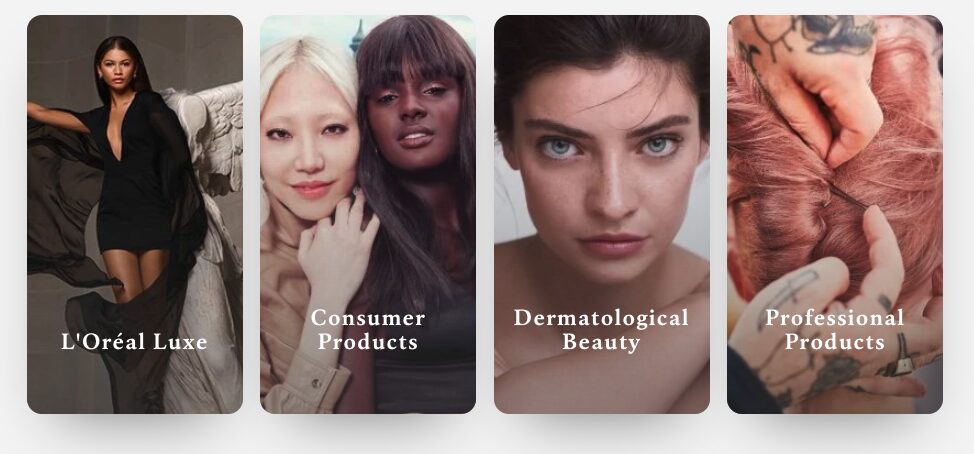
Source: loreal.com
Supercharge your marketing reviews
Share, review, and approve all your content in one place with Filestage.
Greenwashing
- Making deceptive “carbon neutral” or “net zero” claims
- Using bands, sports, or other tactics to greenwash your company’s reputation
Even soft rock bands can get caught up in false advertising.
To ease the guilt of their “carbon-tastic” tours, Coldplay announced it was taking action to reduce its footprint. Enter kinetic dance floors and a partnership with Neste, a Finnish oil company.
Despite claiming to be the world’s largest producer of sustainable biofuels, Neste’s palm oil suppliers cut down 10,000 hectares of forest in 2019 and 2020. This led fans to lash out at the group, earning Coldplay the nickname “useful idiots for greenwashing”.

Source: Photo by Pavol Svantner on Unsplash
Tennis Australia faced a similar backlash when it agreed to a partnership with Aussie oil giant Santos (also being sued for “clean fuel” claims). Many consumers immediately called Santos out for sportswashing.
Lucy Manne, CEO of 350 Australia, had this to say: “There was a big effort to make it unacceptable for cigarette companies to sponsor events … now it’s the time to do the same for fossil fuel companies”.
False testimonials
- Making up positive reviews or endorsements for your products
- Paying for fake reviews and testimonials to give the impression that your product is better quality than it is
Hidden fees or charges
- Hiding or being deliberately misleading about additional costs or fees
- Advertising a lower price and then adding extra fees at the checkout
Bait-and-switch tactics
- Advertising your offering at discounted prices and then trying to sell customers a more expensive product
- Tricking customers into paying more than they intended to pay
Anything that leads a customer to buy your product based on inaccurate information could result in a false advertising lawsuit.
For instance, a beauty brand making claims about a skincare product with no scientific evidence to back them.
Or a certain energy drink overpromising the effects of the product.
As it turns out, Red Bull doesn’t give you wings. Or any more energy-giving benefits than a cup of coffee, for that matter.

Source: Photo by Fonsi Fernández on Unsplash
As a result, Red Bull had to pay a $13 million settlement for using deceptive marketing practices.
The consequences of false advertising
I get it. We’re marketers. We’re always looking for genius new ways to grab consumers’ attention and stand out from the crowd.
But there’s a fine line between ingenious advertising and just deceiving your audience.
And when you cross that line, your business faces some pretty hefty consequences. Especially if you’re in a regulated industry like pharma or consumer goods.
Here’s what your business could be risking.
1. Legal minefields
Lawsuits are expensive. If you get caught engaging in false advertising, your business could face costly product recalls, fines, and loss of revenue.
I’ll take this moment to remind you of the $25 billion Volkswagen emissions scandal.
Now considered one of the biggest cases of corporate fraud of all time, it all started when Volkswagen advertised a new wave of “Clean Diesel” vehicles.
The claims were fraudulent, landing former Volkswagen engineer Oliver Schmidt seven years in prison.
To this day, it’s still one of the harshest white-collar sentences the world has ever seen.
2. Sales take a nosedive
Unsurprisingly, 65% of consumers say they’re unlikely to buy from a brand that advertises near misinformation.
That can hurt your bottom line, even if you don’t actually break any false advertising laws.
3. Reputation in the gutter
When your customers find out that you’ve misled them, you lose their trust. This can cause a pretty sizable dent in your brand reputation, sinking your value.
71% of consumers say brand trust has become more important for them when making buying decisions. Gen Z, in particular, values brand trust highly.
When we consider that Gen Z now has the most spending power, losing consumers’ trust in your brand could be the kiss of death.
4. Health and safety concerns
False advertising or otherwise shady marketing practices can lead to direct health issues for affected consumers.
Just look at Johnson & Johnson.
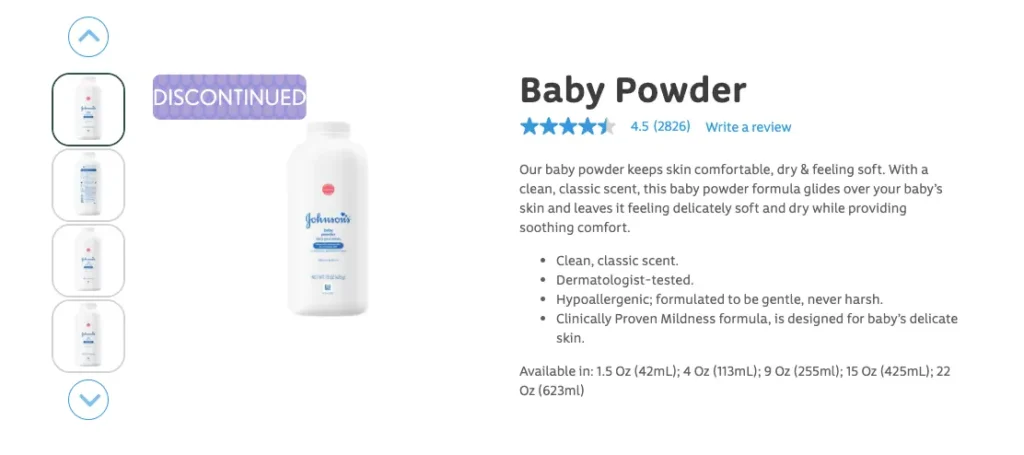
Source: johnsonsbaby.com
Once known for its squeaky-clean image and iconic Baby Powder, the household name found itself in hot water for unethically targeting specific demographics.
These practices created potential health risks for certain demographics of women leading to significant public backlash and reputation damage.
The brand has faced more than 25,000 lawsuits connected to its talc products, with The National Council of Negro Women accusing it of “knowingly deceptive marketing to Black women”.
It recently had to pay $45 million in a talcum baby powder lawsuit.
How to avoid false advertising fails
51% of US consumers think that too many ads exploit people’s fears, insecurities, and emotions.
There’s no denying that some ads set out to mislead consumers (I’m looking at you, tobacco industry).
But it’s not always intentional.
Working in regulated industries like logistics and supply chain or consumer electronics, your business faces strict scrutiny and advertising laws.
The bad news is that most people (consumers or regulatory bodies) don’t care if yours was an honest mistake.
The good news is that I’ve rounded up some tips on how to avoid false advertising flops.
1. Stay in the know
Make it your business to know your industry regulations inside out. Then, set up alerts, subscribe to newsletters, and follow blogs that speak about these regulations.
That way, you can make sure you keep up-to-date on any changes. If you operate in multiple countries, stay on top of updates in each country or region.
Learning from your competitors’ mistakes can also keep you on the straight and narrow.
2. Look at your messaging through a new lens
Rethink your messaging to make it as transparent as possible.
Just because your competitors are making exaggerated claims in their ads, it doesn’t mean you should follow suit.
Take a long hard look at your marketing claims. Are they truthful? Weed out ambiguous language, puffed-up claims, or anything that could mislead your audience. That means saying “no” to puffery or dodgy testimonials.
Unilever has learned this the hard way with its recent greenwashing scandal.
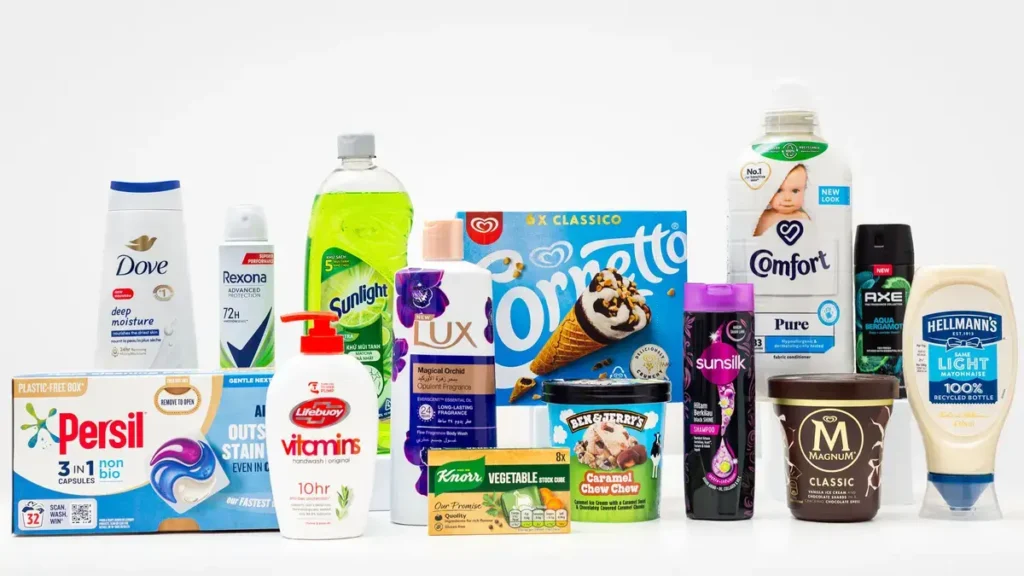
Source: unilever.com
The multinational FMCG company is currently facing an investigation by the UK watchdog Competition and Markets Authority (CMA).
The CMA is looking into potentially misleading advertising from the brand that paints its products as more environmentally friendly than they actually are.
It has come under fire for using “vague and broad” language and for exaggerating how natural its ingredients are. There’s also discussion about whether the use of green on the packaging could be misleading for consumers.
This is a fall from grace for the brand, which has publicly positioned itself as a sustainability advocate.
The lesson?
If you’re making claims, support them with evidence, consumer research, or real-world data. And make sure the data is truthful.
Disclosing the sample size and making sure your sample group represents a diverse population are good places to start. Also, consider whether your sample size is in line with the claim. In other words, if you’re making a big claim, your sample size should be big too.
Does your product have side effects? Be upfront and transparent about these.
3. Mitigate misleading advertising in influencer marketing campaigns
Take a long hard look at your influencer marketing strategy.
How do you choose your influencer partnerships? Do they understand (and comply with) the FTC or local regulatory guidelines? It’s on your business to make sure they do.
If you’re new to the game, your first step is to brush up on social media compliance and get familiar with key regulations. Next, pass the knowledge on to your influencers.
Have you made your stance on deceptive editing practices clear? Setting clear expectations and guidelines on disclosing sponsorship can also help keep your brand compliant.
4. Create a culture of compliance
Get every member of your marketing, sales, and QA teams on the same page with regular training on the relevant advertising regulations and best practices.
The more your teams know, the more likely they are to spot potentially problematic messaging, claims, or packaging design.
When in doubt, call in the big guns.
Consult with specialists in advertising law to make sure your marketing materials are meeting compliance requirements.
5. Bulletproof your creative review and approval process
A well-constructed internal review process is your best line of defense against the murky waters of false advertising.
It makes sure all the major stakeholders (like legal and compliance teams) are involved in reviewing your marketing materials at the right stage of the creative process.
An online proofing platform is the armor here.
It allows you to streamline and manage the full review process with both internal and external stakeholders.
For example, with Filestage, you can:
- Build a seamless and efficient creative operations workflow, cutting approval time by 30%
- Organize and consolidate feedback in a structured way, making mass localization projects easier
- Meet tight deadlines while keeping accuracy high
- Compare document versions to visualize changes (our AI does the heavy lifting for you)
- Set yourself up for a clear audit trail that documents your approval process
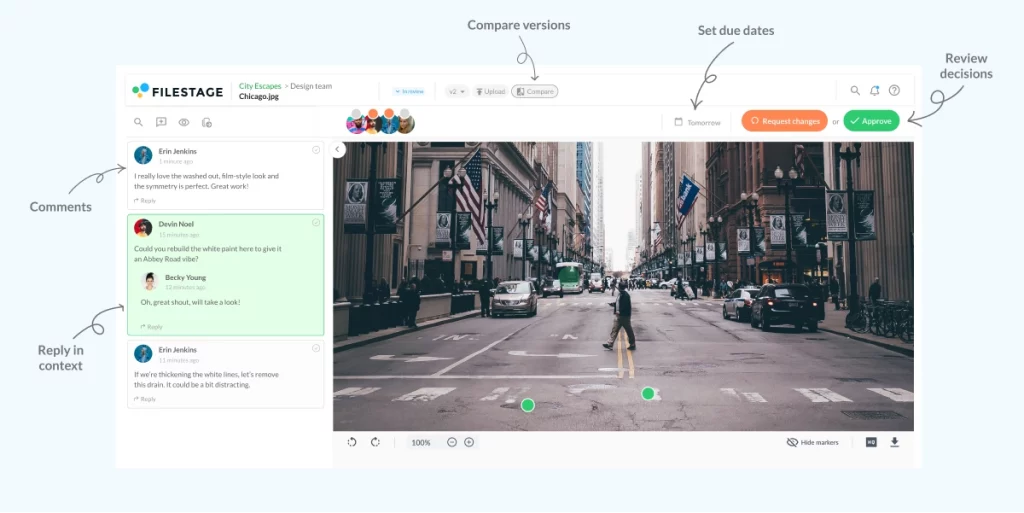
False advertising FAQs
1. What are the most common false advertising examples?
Here are some common false advertising examples that can land your brand in trouble:
- False or misleading advertising claims that exaggerate the benefits of your product
- Using deceptive images in your campaign or marketing strategies
- Being deceptive about the quality or popularity of your products compared to your competitors
- Not disclosing important information about the risks, potential side effects, or limitations of your product
2. How can my business avoid making deceptive advertising claims?
The best way to sidestep misleading advertising and keep consumer trust is to stick to truthful and transparent marketing strategies.
That includes:
- Backing up claims with scientific research and evidence
- Being honest about sample sizes and how you gather, interpret, and advertise customer research
- Staying on top of industry standards and making sure your claims follow best practices and benchmarks
- Avoiding ambiguous language or anything that could be considered false or misleading
- Checking regulatory watchdogs like the Federal Trade Commission to make informed decisions about your advertising claims
3. What are the consequences of false advertising?
As you can see from the false advertising examples in this guide, the consequences are significant. Here are the risks you could face:
- Fines and lawsuits from regulatory bodies like the Federal Trade Commission
- Loss of consumer trust and damage to your company’s reputation
- Drop in sales, loss of partnerships, and fewer advertising opportunities
4. Which industries face the biggest risk of misleading advertising?
False claims can be damaging in any industry, but there are a few regulated sectors that face a higher risk. These include:
- Pharmaceutical and beauty – unsubstantiated health claims could harm public health, so there are strict regulations to protect consumers
- Consumer goods – Regulatory bodies crack down hard on misleading claims about the health benefits of food items, deceptive labeling practices, and unrealistic portion sizes
- Leisure, travel, and tourism – Businesses in this industry must follow strict regulations on pricing transparency and advertising their brand as environmentally friendly
Final thoughts
A false advertisement claim against your company can leave a black mark next to your brand name. Just ask Volkswagen, Red Bull, or Coldplay.
I hope these false advertising examples and best practices help you stay on the straight and narrow, avoiding hefty lawsuits and public backlash.
And if you’re ready to build a bulletproof review and approval process, grab a free Filestage trial today.

